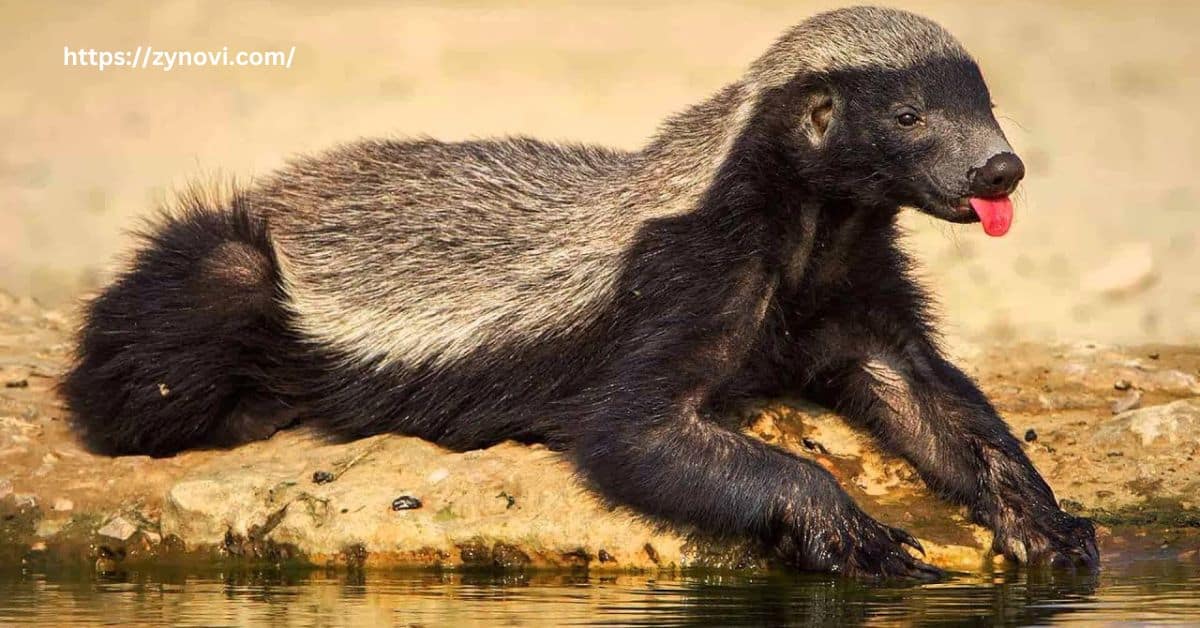Do Honey Badgers Attack Humans? Yes, honey badgers can attack humans, especially if they feel threatened or cornered.
You might have heard of these fearless creatures, known for their audacity and unrelenting spirit. But what happens when these small yet mighty animals cross paths with humans? Is it something you should worry about on your next adventure in their territory?
In this article, we’ll jump into honey badger behavior and explore what triggers their aggression. You’ll also get practical tips on how to stay safe and avoid any dangerous encounters. Stick around to learn all the essential facts and ensure you’re prepared for the unexpected!
What Is a Honey Badger? Fearless Creature
Honey badgers, also known as Ratel (Mellivora capensis), are renowned for their sheer audacity and remarkable resilience. These fearless animals, members of the Mustelidae family (which also includes weasels, otters, and ferrets).
They are found primarily in Africa, the Middle East, and parts of Asia. Despite their small size, honey badgers are often described as “the most fearless creatures” in the animal kingdom, largely due to their aggressive and relentless nature.
Physical Description
| Physical Characteristic | Description |
|---|---|
| Size | Up to 28 inches in length. |
| Body Structure | Stocky, low-set build designed for digging, burrowing, and defense. |
| Purpose of Body Design | Built to defend against larger predators and engage in digging activities. |
Here are some key physical traits that make the honey badger a fearsome survivor:
- Thick Loose Skin: The loose, tough skin of a honey badger is a critical defense mechanism, allowing them to twist and turn without serious injury when grabbed by predators. This unique feature also helps to avoid injury from bites and scratches.
- Sharp Claws and Powerful Jaws: Honey badgers are armed with long, sharp claws capable of digging into the hardest earth, and their jaws are powerful enough to crush bones, making them formidable against other animals.
- Scent Gland: When threatened, honey badgers have the ability to release a foul-smelling secretion from a gland near their anus. This defensive scent is enough to repel most predators, including lions and leopards.
Habitat and Distribution
Honey badgers are highly adaptable creatures and can thrive in a variety of habitats, including:
- Savannas and Grasslands: These open plains provide a good supply of prey, including rodents, insects, and the occasional snake.
- Desert Regions: In Africa and the Middle East, honey badgers can survive in the harsh, arid conditions of the desert. Their ability to go without water for long periods is one of their survival skills.
- Forest and Mountainous Areas: Honey badgers also live in more densely vegetated regions, where they use their burrowing skills to create shelters.
Their wide range across Africa, Asia, and parts of the Middle East shows just how resilient and resourceful these animals are. They often make their dens in burrows or caves, which they protect fiercely.
Honey Badger Behavior

Aggression and Fearlessness
Honey badgers are well-known for their aggressive nature. This aggression is rooted in their survival instincts rather than malice. In fact, their tendency to confront danger head-on is part of what makes them one of the most fearless animals in the wild.
They are known to engage with predators such as lions, leopards, and even crocodiles, often emerging victorious or at least escaping unharmed.
Here are some behaviors that highlight their fearless nature:
- Territoriality: Honey badgers are highly territorial and will not hesitate to fight to defend their home or food. They use their sharp claws and teeth to fiercely protect their burrows and resources.
- Resourcefulness: They’re not just physically tough; honey badgers are incredibly intelligent. They are known to solve complex problems, such as opening beehives to steal honey, which is why they are often referred to as “honey badgers” in the first place.
Survival Tactics
Honey badgers have developed several mechanisms to help them survive in the wild. Some of their most impressive survival tactics include:
- Counterattack Strategy: When confronted, honey badgers will often use a counterattack strategy. This involves striking back with their powerful claws or biting their attacker.
- Climbing and Escaping: Honey badgers are excellent climbers, and when faced with larger predators, they can quickly scale trees or rocky surfaces to escape danger.
Despite their small size, honey badgers have earned a reputation for being some of the most formidable creatures in their habitats.
Do Honey Badgers Attack Humans?
While honey badgers have a reputation for aggression, attacks on humans are incredibly rare. These animals do not actively seek out humans as prey. However, like many wild animals, honey badgers will defend themselves if they feel threatened.
A typical scenario might involve a honey badger feeling cornered or provoked, in which case it could lash out with bites or scratches.
Factors Contributing to Attacks
Honey badgers are generally not interested in humans, but there are specific situations where an attack could occur:
- Feeling Threatened: If a honey badger feels cornered or is surprised by a human, it may become aggressive to protect itself.
- Protecting Food or Young: Like many animals, a honey badger will fiercely defend its food or young from any perceived threats. In such situations, a human getting too close could provoke an attack.
- Rabid Honey Badgers: A rabid honey badger may act erratically, and rabies could cause the animal to attack humans more aggressively than usual.
In all likelihood, honey badgers will avoid humans unless they have no choice. However, their aggression in self-defense can make an encounter dangerous.
How Often Do Attacks Occur?

Honey badger attacks on humans are rare but not unheard of. According to reports, most incidents of honey badger attacks involve farmers or people who come into direct contact with the animals in their natural habitat.
Notable Case Studies: Honey Badger Encounters with Humans
- Farmer Interaction in South Africa: In one documented case, a farmer in South Africa was attacked by a honey badger after accidentally stepping too close to its burrow. The farmer was scratched and bitten, requiring medical treatment for the wounds.
- Tourists and Wildlife Interaction: Tourists who attempt to interact with honey badgers in the wild have sometimes faced attacks when they get too close to the animal’s territory.
These cases are uncommon, but they emphasize the importance of respecting wildlife and avoiding close encounters with these fearless animals.
The Danger of Honey Badger Attacks
Injury Potential
Although honey badger attacks on humans are rare, they can result in significant injury. The key risks include:
- Bites: A honey badger’s bite is incredibly powerful and can cause deep puncture wounds or cuts. Their strong jaws and sharp teeth make their bites particularly dangerous.
- Scratches: Honey badgers’ claws are designed for digging, but they are also effective in self-defense. A swipe from a honey badger can cause deep scratches that might lead to infection.
- Rabies Risk: Like many wild animals, honey badgers can carry rabies, a potentially fatal viral disease. Rabies can cause aggression and erratic behavior in animals, increasing the danger of an attack.
Severity of an Attack
The severity of a honey badger attack depends on several factors, including:
- Location of the Injury:
A bite to vital areas such as the hands, face, or neck can be far more dangerous due to the proximity to major blood vessels and nerves. These injuries may result in excessive bleeding, infection, or long-term damage if not treated promptly. - Prompt Medical Attention:
Receiving medical attention quickly after a honey badger attack is crucial to avoid complications. Immediate care can help prevent infections from the bacteria present in the animal’s mouth and protect against diseases like rabies, which may be transmitted through the bite.
While honey badgers are not typically lethal to humans, they are capable of inflicting serious harm, particularly if left untreated.
The Bottom Line: Should You Be Worried?
Honey badgers, despite their aggressive nature, do not typically pose a major threat to humans. Attacks are rare, and most occur when the animal is provoked or feels threatened. However, it’s important to approach these creatures with respect and caution, especially if you’re in their natural habitat. They are not animals to underestimate.
How to Stay Safe From Honey Badger Attacks

If you are traveling in areas where honey badgers are common, such as parts of Africa, the Middle East, or India, here are some important safety tips:
- Stay Aware of Your Surroundings:
Always be alert when traveling in honey badger territory. Look for signs of their presence, such as tracks, burrows, or markings. Staying observant can help you avoid accidental encounters with these animals. - Respect Their Space:
Honey badgers are highly territorial and will defend their space fiercely. Keeping a safe distance is essential to prevent triggering their aggression. Never try to touch, corner, or provoke them in any way. - Avoid Surprising a Honey Badger:
Sudden movements or loud noises can startle honey badgers, causing them to react defensively. To minimize the risk of an attack, move quietly and steadily, and avoid surprising them or their young.
FAQs
Are honey badgers friendly to people?
Honey badgers are not naturally friendly to humans and can be very defensive if they feel threatened.
How aggressive is a honey badger?
Honey badgers are highly aggressive, especially when protecting their territory or young, and can attack without provocation.
Would a honey badger beat a pitbull?
Despite their size, honey badgers are known for their fearlessness and toughness, and could potentially hold their ground against a pitbull in a fight.
Can you outrun a honey badger?
Honey badgers can run up to 19 mph (30 km/h), making it difficult for most people to outrun them in the wild.
Conclusion: Do Honey Badgers Attack Humans
In conclusion, honey badgers are not typically a threat to humans, but they are capable of aggression when provoked. While honey badger attacks are rare, they can result in injury, particularly from bites or scratches. If you find yourself in honey badger territory, respecting their space and following safety guidelines is crucial to avoiding conflict.
By understanding honey badger behavior, their defensive mechanisms, and how to act if you encounter one, you can safely coexist with these incredible, fearless creatures in the wild. Always remember: it’s not about the size of the animal, but its tenacity and survival instincts. Respect the honey badger, and you’ll reduce the risk of any dangerous encounters.










